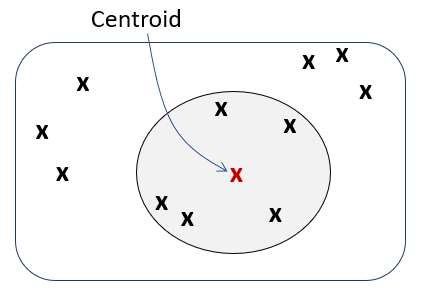AVG
The AVG function takes a vector expression as input and
returns the average as a vector with format FLOAT64.
Purpose
AVG is mainly used to create an overall representation (as in a
centroid) for a vector set. In applications like Natural Language Processing (NLP),
you can compute the average of several vectors to create a single centroid or
overall representation. For example, to represent a sentence, you might average the
word embeddings of each word in the sentence. This can be used for tasks like text
classification, document similarity, or clustering.
The result of AVG with a vector expression is the equivalent of
consecutively performing vector addition operations on all non-NULL
inputs and then dividing by the total number of non-NULL inputs.
The returned vector has the same number of dimensions as the input and has the
format FLOAT64. When the expression has a flexible number of
dimensions, all inputs must have the same number of dimensions within each aggregate
group.
The AVG function with vector expressions as input can be
used as a single set aggregate or in the GROUP BY clause. Using
ROLLUP is also supported. The AVG function
accepts vector expressions as input for aggregate operations but cannot currently be
applied to analytic operations.
NULL vectors are ignored and are not counted when
calculating the average vector. If all inputs within an aggregate group are
NULL, the result is NULL for that group. If
the result overflows the FLOAT64 maximum value, an error is raised,
regardless of the format of the input vector type.
With vector inputs, using DISTINCT,
CUBE, and GROUPING SETS is not supported.
Also, BINARY and SPARSE vectors cannot be supplied
as input.
For the full definition and implementation of the AVG
function, see Oracle Database SQL
Language Reference.
CREATE TABLE avg_t (v VECTOR, k1 NUMBER, k2 VARCHAR2(100));
INSERT INTO avg_t VALUES ('[2, 4, 6]', 2, 'even');
INSERT INTO avg_t VALUES ('[8, 10, 12]', 2, 'even');
INSERT INTO avg_t VALUES ('[1, 3, 5]', 3, 'odd');
INSERT INTO avg_t VALUES ('[7, 9, 11]', 3, 'odd');
SELECT AVG(v) v_avg FROM avg_t;
V_AVG
---------------------------------------------------
[4.5E+000,6.5E+000,8.5E+000]
SELECT AVG(v) v_avg, k1 FROM avg_t GROUP BY k1;
V_AVG K1
--------------------------------------- ----------
[5.0E+000,7.0E+000,9.0E+000] 2
[4.0E+000,6.0E+000,8.0E+000] 3
SELECT AVG(v) v_avg FROM avg_t GROUP BY ROLLUP(k1, k2);
V_AVG
---------------------------------------------------
[5.0E+000,7.0E+000,9.0E+000]
[5.0E+000,7.0E+000,9.0E+000]
[4.0E+000,6.0E+000,8.0E+000]
[4.0E+000,6.0E+000,8.0E+000]
[4.5E+000,6.5E+000,8.5E+000]
Parent topic: Aggregate Functions

